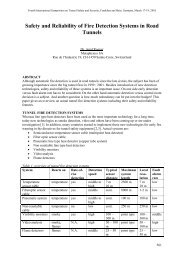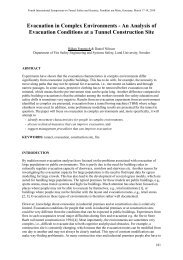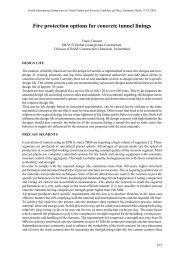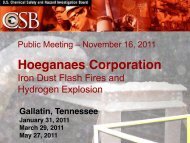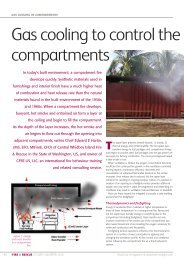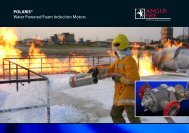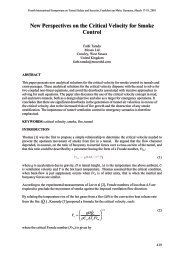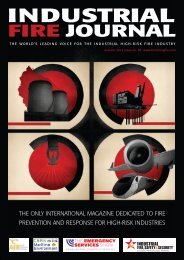30-37 TunnelsREV[1]rev.qxd - Industrial Fire Journal
30-37 TunnelsREV[1]rev.qxd - Industrial Fire Journal
30-37 TunnelsREV[1]rev.qxd - Industrial Fire Journal
Create successful ePaper yourself
Turn your PDF publications into a flip-book with our unique Google optimized e-Paper software.
TRANSPORT: TUNNELS<br />
Tunnel fire safety research<br />
constructions of new challenging and complex infrastructure<br />
systems have been the driving force for the European Commission<br />
(EC) to finance several pan European research projects.<br />
Haukur Ingason and Ulf Wickström, SP Technical<br />
Research Institute of Sweden, provide an overview of<br />
research projects into tunnel fire safety in Europe.<br />
Figure 1: The<br />
Runehamar fire<br />
tests carried out in<br />
2003 as a<br />
collaboration<br />
project between<br />
SP [3] and the<br />
European UPTUN<br />
project [2].<br />
Tunnels are becoming increasingly important at the same time<br />
as they become more complex. The increase in traffic<br />
volumes and the construction of complex underground<br />
systems in Europe have put focus on the fire problem in tunnels.<br />
The large and costly fire accidents that have occurred and the<br />
increase in tunnel investments are key factors for the growing<br />
interest in tunnel fire safety research.<br />
European investments in tunnels are estimated to be about<br />
150,000 million Euros between 2005 and 2010. Tunnel fires cost<br />
up to 200 million Euros per year for the European industry. Large<br />
economic gains could therefore be achieved by designing safety in<br />
underground facilities in an efficient and safe manner.<br />
The traffic volumes in Europe are estimated to increase by<br />
approximately 50% for private transport and by 100 % for freight<br />
traffic by 2020. At the same time public transport will increase. A<br />
total of approximately 2,500 km of new tunnels will be built in<br />
Europe in the coming years. This enormous expansion of traffic and<br />
new construction requires new innovative solutions and knowledge<br />
on how to build/safely operate these tunnels.<br />
The tragic fire accidents that have occurred in Europe show clearly<br />
importance reducing the impacts of a tunnel fire. Over 500 people<br />
have died in tunnel fires in the last 15 years whereas world-wide<br />
more than 800 people have died during the same time. In addition<br />
to the casualties fires result in long-term halts in critical traffic<br />
arteries. Authorities have become more and more aware of the<br />
vulnerability of the traffic systems, eg the recent fire in the Channel<br />
Tunnel between Britain and France on September 11, 2008, which<br />
resulted in no fatalities, created huge disturbances in the tunnel<br />
traffic and caused great economic losses. Major damage to the<br />
concrete made the tunnel unsafe to operate fully for a long time, as<br />
the reparation was very time consuming and required extensive<br />
knowledge on concrete strength after the repair.<br />
These severe accidents, high investment costs and the on-going<br />
Major European projects<br />
The research projects sponsored by the EC have all generated new<br />
knowledge. The following projects are briefly presented here:<br />
• Durable and Reliable Tunnel Structures (DART 2001-2004),<br />
• Upgrading Methods for <strong>Fire</strong> Safety in Existing Tunnels (UPTUN<br />
2001-2004),<br />
• Innovative systems and frameworks for enhancing of traffic<br />
safety in road tunnels (SAFE TUNNEL 2001-2004),<br />
• Safety Improvement in Road & rail Tunnels using Advanced ICT<br />
and Knowledge Intensive DSS (SIRTAKI 2001-2004),<br />
• European thematic network on fire in tunnels (FIT 2001-2005),<br />
• Thematic Network on development of European guidelines for<br />
upgrading tunnel safety (Safe-T 2003-2006),<br />
• Large Scale Underground Research Facility (LSURF 2005-2008).<br />
These projects are more or less a mixture of desktop research,<br />
small and large scale testing, product development, guidelines and<br />
large scale demonstrations. The objectives were usually very broad,<br />
everything from traffic management, risk analysis, construction<br />
protection, mitigation and warning techniques as well as human<br />
behaviour. Here follows a short summary of each project:<br />
The DART project[1] considered tunnel design and construction.<br />
The main objective was to develop operational methods and tools<br />
to support operators to make the best pro-active decisions. The aim<br />
was to select a cost optimal tunnel type and construction process in<br />
which all decision parameters could be considered. Tools for<br />
decision support for cost-optimal tunnelling and incorporation of<br />
environmental, geotechnical aspects, technical qualities, and<br />
structural life safety considerations were developed.<br />
The UPTUN project[2] focused on upgrading methods for fire<br />
safety in existing tunnels. Development of innovative technologies<br />
and an assessment of existing technologies for tunnels were carried<br />
out. Focus was on detection and monitoring, human response,<br />
mitigating measures such as water spray systems, and protection of<br />
structures. Numerous large scale tests were carried out, of which<br />
the Runehamar tests[3] are the most well known (Figure 1). Other<br />
important tests were on water spray systems in tunnels[4], which<br />
resulted in engineering guidelines for tunnel water mist systems.<br />
The SAFE TUNNEL project[5]. The main objective was to reduce<br />
the number of accidents in road tunnels by p<strong>rev</strong>entive<br />
measurements. An ”intelligent tunnel" and an "intelligent vehicle"<br />
interacted, so that information about the vehicle's operational status<br />
could be fully exploited. Tunnel operators can then determine<br />
whether and how the vehicle is allowed to use the tunnel<br />
depending on the vehicle status. This feature can reduce the<br />
number of stops in the tunnel.<br />
The SIRTAKI project[6]. The main objective was to create an<br />
advanced decision support system for tunnel operators when<br />
responding to/dealing with incidents. The system is innovative in<br />
respect to key aspects of tunnel management including tunnel<br />
operator support, integrated management of the network as a<br />
whole, improved sensors and improved surveillance. The benefits<br />
were mainly enhanced tunnel safety, reduced stress for the<br />
operators and others involved in an incident.<br />
<strong>30</strong> ❘ INDUSTRIAL FIRE JOURNAL ❘ FIRST QUARTER 2011 Read our magazine at www.hemmingfire.com
in Europe<br />
The FIT[7] was a European network project which coordinated<br />
and optimised tunnel fire safety research. It resulted in very good<br />
overviews of standards and regulations for tunnels and in a<br />
collection of data from real tunnel fires and other data, in particular<br />
fire temperatures and heat release rates to be used for design<br />
purposes, so-called “design” fires. The overview included road,<br />
railway as well as subway tunnels. The project report contains basic<br />
principles for fire design, underground fire statistics and consequences<br />
of fire/smoke spread on people, equipment and structures.<br />
The Safe-T[8]. The main objective was to develop good practices<br />
for making optimal decisions with respect to security in European<br />
tunnels, primarily for road tunnels, but also railway tunnels; to find<br />
practical solutions for p<strong>rev</strong>enting/avoiding accidents in existing<br />
tunnels, to limit the range of possible accidents; and to ensure a<br />
high level of safety in European tunnels.<br />
L-SURF[9] is a joint initiative by five European leading institutes on<br />
safety and security of underground spaces (VSH in Switzerland,<br />
STUVA in Germany, SP in Sweden, Ineris in France and TNO in the<br />
Netherlands). The initial project included surveying existing test<br />
facilities, identifying research needs, outlining lay-out and geometry<br />
of a future research facility, defining measurement techniques<br />
suitable to use in the facility, and defining activities in terms of R&D.<br />
Technical results of European projects<br />
The technical results from the above mentioned European projects<br />
are very broad and comprehensive. Below we have summarised<br />
the most important results from four main topics (design fires,<br />
active fire protection, passive fire protection, egress).<br />
Tunnel design fires<br />
Design fires were discussed and investigated in many of the<br />
projects. A design fire is not necessarily the worst fire that may<br />
occur, but a conscious choice between the probability that it may<br />
arise and the ability to achieve practical solutions. Therefore,<br />
different design scenarios are often used for various safety systems.<br />
In the FIT and UPTUN projects’ literature compilations were<br />
carried out and overviews of heat release rates as a function of<br />
time for several types of vehicles. These compilations show that the<br />
peak heat release rates of various commonly used design fires<br />
differ a lot, especially with regard to heavy goods vehicles.<br />
Documented heat release rates from real accidents differs greatly as<br />
well. For other types of vehicles, the difference is not as great.<br />
Literature suggests that the peak heat release rates for single<br />
passenger cars (small and large) lies between 1.5 MW and 8 MW,<br />
although the majority of the real tests show heat release rate values<br />
less than 5 MW. When two cars are involved the peak heat release<br />
rate varies between 3.5 MW and 10 MW. Time to peak heat<br />
releaser rate is between 10 and 55 minutes. The peak heat release<br />
rates for the HGV trailers vary from 13 MW to more than 200 MW,<br />
depending on the fire load of the goods. The time to reach the<br />
peak HRR is in the range 10-20 minutes. The Runehamar tests[3]<br />
of UPTUN were very significant as they showed that very high HRR<br />
could develop from HGVs. For rolling stocks (train, subway etc) the<br />
heat release rates vary from 7 MW to 43 MW and the time to<br />
reach the peak heat release rate varies from 5 to 80 minutes.<br />
The UPTUN project[10] recommended two sets of design fire<br />
scenarios based on data obtained mainly from Runehamar tests:<br />
A) <strong>Fire</strong> scenarios where tunnel users, rescue teams and installed<br />
Risk to life<br />
HRR MW vehicles<br />
vehicles<br />
Road, examples Rail, examples<br />
Risk to construction<br />
equipment necessary to provide safe evacuation and rescue<br />
operations (human safety) are at risk, and<br />
∫B) fire scenarios where the protection of the tunnel boundary<br />
structure is at risk or where unwanted spread of fire and smoke<br />
by ventilation ducts or through fire doors may occur.<br />
Under the first point A) design scenarios were recommended for<br />
human safety in terms of heat release rate, while under B) design<br />
fires were recommended for fire resistance estimations in terms of<br />
time-temperature curves. This approach follows how fire safety is<br />
expressed in the building regulations and allows the application of<br />
some commonly accepted methods for the documentation of fire<br />
resistance. In general, UPTUN recommends several fire scenarios<br />
are used for risk analysis of tunnels, as it is significant to know how<br />
any possible scenarios may contribute to the overall hazard. Small<br />
fires might cause problems other than larger fires. For A) human<br />
safety, all proposed scenarios from 5MW up to the actual design<br />
fire are recommended to be considered in risk analyses (Table 1).<br />
UPTUN proposes that the duration of a fire is determined by the<br />
amount of combustible material, assuming that all the fuel is<br />
consumed at a combustion efficiency of 80%. The amount of fuel<br />
depending on the type vehicles, load and traffic pattern should<br />
always be evaluated for each study. In particular traffic at standstill<br />
can increase the amount of available combustible material.<br />
Under the second point B) design scenarios were recommended<br />
for fire resistance. Three curves are recommended, ISO 834,<br />
Hydrocarbon Curve (HC) and RWS-curve, see Figure 2. The same<br />
rule for duration applies as for type A) scenarios.<br />
Active fire protection in tunnels<br />
Within the UPTUN project, extensive analysis and testing of water<br />
spray systems in tunnels were carried out[4] to find new, innovative<br />
and optimal solutions for fire protection in existing tunnels. Various<br />
automatic water spray systems were described and evaluated in<br />
different large scale tests. The focus was on controlling the fire<br />
development and fire spread, and not necessarily to suppress<br />
them. Effects of ventilation together with water spray systems were<br />
not considered specifically.<br />
Metro, examples<br />
vehicles<br />
At the<br />
fire<br />
boundary<br />
(Figure 2)<br />
5 1-2 cars ISO 834<br />
10 Small van, 2-3 cars,<br />
++<br />
20 Big van, public bus,<br />
multiple vehicles<br />
Electric<br />
locomotive<br />
<strong>30</strong> Bus, empty HGV Passengers<br />
carriage<br />
50 Combustibles load<br />
on truck<br />
70 HGV load with<br />
combustibles<br />
(approx. 4 tonne)<br />
Open freight<br />
wagons with<br />
lorries<br />
Low combustible<br />
passengers<br />
carriage<br />
Normal<br />
combust i ble<br />
passengers<br />
carriage<br />
ISO 834<br />
ISO 834<br />
Two Carriages ISO 834<br />
Multiple carriages<br />
(more than two)<br />
ISO 834<br />
100 HGV (average) HC<br />
150 Loaded with easy<br />
comb. HGV (approx.<br />
10 tons)<br />
200 or<br />
higher<br />
Limited by oxygen,<br />
petrol tanker,<br />
multiple HGVs<br />
Limited by<br />
oxygen<br />
The following fire growth rate ( α<br />
g, L<br />
) were recommended by UPTUN:<br />
Peak HRR of fire ≤ <strong>30</strong>MW, => α<br />
g, L<br />
= 10 MW/min<br />
Peak HRR of fire > <strong>30</strong>MW, => α = 20 MW/min<br />
g, L<br />
HC<br />
RWS<br />
RWS<br />
Table 1:<br />
fire scenario<br />
recommendation,<br />
see UPTUN WP2<br />
[10].<br />
Read our magazine at www.hemmingfire.com FIRST QUARTER 2011 ❘ INDUSTRIAL FIRE JOURNAL ❘ 31
TRANSPORT: TUNNELS<br />
Figure 2:<br />
recommended<br />
time temperature<br />
curves for fire<br />
resistance design.<br />
Temperature [ o C]<br />
1400<br />
1200<br />
1000<br />
800<br />
600<br />
400<br />
200<br />
One important conclusion from UPTUN is that every system is<br />
unique, and therefore testing and documentation is important to<br />
ensure the desired function and quality of the system. It must be<br />
able to operate in conjunction with other mitigation measures (eg<br />
ventilation systems). Installation of automatic systems is associated<br />
with significant investment costs and it is essential to have control<br />
of the operating and maintenance costs. Water spray systems will in<br />
general improve ventilation conditions and the ability to escape<br />
from a tunnel fire. In particular, such systems are valuable for saving<br />
people who are for some reason unable to evacuate themselves.<br />
Water spray also reduces the thermal exposure to tunnel structures<br />
and therefore eg reduce the risk of explosive spalling of concrete.<br />
In heavily trafficked urban tunnels extinguishing and ventilation<br />
systems may be very useful. They may p<strong>rev</strong>ent rapid fire spread<br />
and reduce the effects of fire on people, and provide better tunnel<br />
access and rescue conditions for first responders. As water spray<br />
systems are very effective for reducing the thermal exposure level<br />
on the tunnel construction and equipment, they could considerably<br />
reduce the total costs in case of fire in tunnels.<br />
UPTUN showed that tests with both low and high pressure water<br />
mist systems required significantly less water than ordinary water<br />
spraying systems in tunnels. The efficiency was strongly dependent<br />
on the size of the fire, nozzle type, location and water discharge<br />
rates. A rapid reduction of the temperatures downstream of the fire<br />
was noticed after activation of the water spray system. The visibility<br />
was, however, not improved during the first minutes after activation,<br />
but later on as the fire size and the heat release rate were reduced.<br />
The problem of back layering (ie smoke spreading upstream) and<br />
the visibility upstream were also significantly improved after<br />
activation of water mist systems.<br />
One part of UPTUN was to carry out demonstration tests in a<br />
large scale tunnel. Thus a section of a high pressure water mist<br />
system was installed in the Virgolo tunnel in Italy and used to<br />
demonstrate the effectiveness of such a system in a fire. As a result<br />
of the successful tests, a complete high pressure water mist system<br />
was later permanently installed as part of the upgrading of Virgolo.<br />
Protection of concrete structures<br />
Researchers in Europe have worked on methods to reduce<br />
explosive "spalling" in structures of high performance/strength and<br />
self-compacting concrete. In most cases structures made of these<br />
types of concrete need to be protected with a passive fire<br />
protection barrier such as shotcrete (sprayed concrete), or boards<br />
of mineral wool or ceramic materials. Alternatively polypropylene<br />
0<br />
0 20 40 60 80 100 120<br />
Time [min]<br />
ISO 834<br />
Hydrocarbon (HC)<br />
RWS<br />
fibres may be mixed into high performance or self-compacting<br />
concrete. The risk for spalling in case of fire is then reduced<br />
considerably. Another possible approach that has been suggested is<br />
to expand the dimensions of the concrete cross section so that<br />
some spalling may occur without causing unacceptable damage. All<br />
the European research projects that dealt with the problem of<br />
spalling (DART, UPTUN and FIT) recommend similar technical<br />
solutions for protecting tunnel constructions[11].<br />
The surface insulation must be so thick that the temperature at<br />
the surface or just inside the concrete structure must not exceed<br />
certain values depending on the concrete strength. In the DART<br />
project it is stated that if the surface temperature is kept under a<br />
level of 380 o C and the temperature at 25 mm inside the concrete<br />
is lower than 250 o C, the risk for spalling is deemed insignificant.<br />
The European projects recommend that the quantity of<br />
polypropylene should be between 1-3 kg/m 3 depending on<br />
assumed design fire and type of concrete eg in the FIT project a<br />
mixture of 2-3 kg/m 3 of polypropylene is recommended whereas<br />
in the DART project the recommended amount of polypropylene is<br />
stated to depend on the design fire curve assumed:<br />
• 1-2 kg/m 3 for ISO 834 fire.<br />
• 3 kg/m 3 for RABT curve (German curve).<br />
In the UPTUN project the following recommendations and<br />
methods for the design of concrete structures were given[11]:<br />
• Insulate tunnel surfaces with eg sprayed concrete, theramic or<br />
mineral boards.<br />
• Mix polypropylene fibres into concrete in appropriate quantities.<br />
• Assure that protective layers of shotcrete have aggregates with<br />
maximum size of 8 mm. The minimum thickness of the<br />
shotcrete should be 20 mm.<br />
• Test fire resistance for 2 hours at 1,200 0 C.<br />
• Fastened protective boards properly into the concrete.<br />
• Assure that the concrete surface temperature does not exceed<br />
350 0 C and that the temperature at 40 mm depth does not<br />
exceed 250 0 C.<br />
Egress from tunnels<br />
Numerous studies and demonstrations carried out in the European<br />
tunnel fire safety research projects show how difficult and<br />
unpredictable human behaviour is in case of a tunnel fire. From real<br />
incidents, it has been observed that people react too slowly and<br />
therefore they have not enough time to reach escape routes.<br />
Important observations and recommendations from the European<br />
research projects are[11]:<br />
• Alarm alone rarely leads to evacuation without additional<br />
information.<br />
• The self-assessment of individual determines which actions will<br />
be carried out.<br />
• People rarely panic unless they fear they are unable to evacuate.<br />
• Individuals tend to follow the action pattern of the majority.<br />
• Trustworthy/authoritarian people usually facilitate an emergency.<br />
• Tunnel occupants are reluctant to use unfamiliar escape routes.<br />
• Instructions in foreign languages increase the uncertainties.<br />
• Tunnel occupants must understand or be aware of seriousness<br />
of a possible critical situation.<br />
• Instructions on how to act in case of emergency must be clear.<br />
• Extremely long tunnels must be avoided.<br />
• Designers must rely on self-evacuation.<br />
Key to improving the situation in critical situations is:<br />
• The tunnel operator has an overview/understands the incident.<br />
• There must be relevant communications to the tunnel<br />
occupants so that they themselves understand the seriousness<br />
and ultimately make the right decisions.<br />
A general conclusion is that tunnel occupants cannot rely on any<br />
active support from the rescue services in case of fire.<br />
32 ❘ INDUSTRIAL FIRE JOURNAL ❘ FIRST QUARTER 2011 Read our magazine at www.hemmingfire.com
Discussion<br />
Pan-European projects have created new and useful information for<br />
authorities, researchers and engineers working with tunnel fire<br />
safety eg the Runehamar tests, the large scale demonstration tests,<br />
human behaviour tests and water spray tests. Traffic management,<br />
risk analysis as well as human behaviour are also examples of<br />
research areas where new and important knowledge were<br />
obtained. The understanding developed on spalling of high<br />
performance concrete has lead to valuable practical<br />
recommendations on how to protect tunnels. All this new<br />
knowledge about tunnel construction will in the long term find its<br />
way into standardisation and will increase the safety level in tunnels.<br />
None of the projects focused on smoke ventilation or smoke<br />
control, which is still a very interesting research area, as the EC was<br />
of the opinion that therE was no need for further research in this<br />
area[11]. The International Tunnel Association ITA created in May<br />
2005 following a joint initiative of eight European research projects<br />
the Committee on Operational Safety of Underground Facilities<br />
COSUF[12]. The COSUF scope concerns the operational safety of<br />
tunnels and underground facilities in general but included also the<br />
aspects of security. The creation of COSUF was a natural step in the<br />
development of closer ties between the different research groups.<br />
Another good example of what these projects can lead to is the<br />
establishment of L-surF [9], which aims to be a leading player in<br />
European tunnel research activities. SP is one of the founders of<br />
this organisation together with VSH in Switzerland, STUVA in<br />
Germany, INERIS in France, and TNO in the Netherlands.<br />
Conclusion<br />
The pan-European projects sponsored by the EC have raised the<br />
level of knowledge on tunnel fire safety. The success varies<br />
depending on the field. Within traffic management and risk analysis<br />
many interesting projects and models were developed. UPTUN’s<br />
work on human behaviour is a good example of useful research.<br />
The large scale tests in the Runehamar have already been widely<br />
used for comparison/validation by several researchers around the<br />
world, and served as a basis for the development of design fires in<br />
standards such as NFPA 502[13] for road tunnels. A<br />
recommendation on avoiding explosive spalling is also a good<br />
example of useful information. The water spray tests and the large<br />
scale demonstration tests have all given basic knowledge that have<br />
pushed the technological development within the area forward.<br />
References<br />
1. DARTS, Durable and Reliable Tunnel Structures – The reports (CD Rom)<br />
2004, : CUR Gouda, The Netherlands.<br />
2. UPTUN - Final Technical Report - Document UPTUN FTR v10 20061204. 2006.<br />
3. Ingason, H. and A. Lönnermark, Heat Release Rates from Heavy Goods Vehicle<br />
Trailers in Tunnels. <strong>Fire</strong> Safety <strong>Journal</strong>, 2005. 40: p. 646-668.<br />
4. K. Opstad, J.P. Stensaas, and A.W. Brandt. <strong>Fire</strong> mitigation in tunnels, experimental<br />
results obtained in the Uptun project. in 2nd Int. Symp. on Tunnel Safety and<br />
Security. 2006. March 15-17, Madrid, Spain.<br />
5. R. Brignolo, et al., SAFE TUNNEL in Safety ITS congress. 2002: Lyon, France.<br />
6. SIRTAKI Safety Improvements in Road&Rail Tunnels using Advance ICT and<br />
Knowledge Intensive DSS - Final Report 2001 - 2004. 2004.<br />
7. FIT – <strong>Fire</strong> in Tunnels - Thematic Network - General report 2006: www.etnfit.net.<br />
8. SAFET-T www.crfproject-eu.org.<br />
9. Felix Amberg and M. Wietek, L-surF: Large Scale Underground Research Facility<br />
on Safety and Security, in Proceedings from the 3rd International Symposium on<br />
Tunnel Safety and Security. 2008: Stockholm, Sweden.<br />
10. Opstad, K., <strong>Fire</strong> scenarios to be recommended by UPTUN WP2 Task leader<br />
meeting of WP2. 2005.<br />
11. Høj, N.-P., et al., NordFoU samarbetet - Utvärdering av EU-projekt om<br />
vägtunnelsäkerhet, Report nr. H-SE-011 2009: (in Swedish).<br />
12. Amberg, F., ITA COSUF – SCOPE, ACTIVITIES, STRUCTURE The Committee on<br />
Operational Safety of Underground Facilities of the International Tunneling and<br />
underground space Association, in Think Deep. 2008: Amsterdam.<br />
13. NFPA 502 - Standard for Road Tunnels, Bridges, and Other Limited Access<br />
Highways. 2011 Edition, National <strong>Fire</strong> Protection Association.<br />
– your solution for optimal<br />
alert management<br />
RES.Q terminal<br />
Alerting using digital paging (POCSAG)<br />
Confirmation with GPRS/SMS<br />
Optional GPS localisation<br />
High sensitivity, long battery life<br />
DE925/DE920Ex digital POCSAG receiver<br />
Alerting using digital paging (POCSAG)<br />
High sensitivity, long battery life<br />
Supports IDEA TM encryption, Express Alarm ®<br />
ATEX protection class<br />
www.swissphone.com<br />
Read our magazine at www.hemmingfire.com FIRST QUARTER 2011 ❘ INDUSTRIAL FIRE JOURNAL ❘ 33


![30-37 TunnelsREV[1]rev.qxd - Industrial Fire Journal](https://img.yumpu.com/22237435/1/500x640/30-37-tunnelsrev1revqxd-industrial-fire-journal.jpg)
